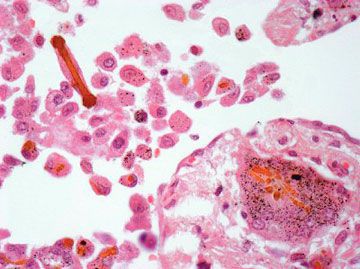 For decades, American women have relied upon the Pap test to detect cervical cancer and precancerous cells. But a large study out of Holland suggests that combining the Pap test with a test for human papillomavirus (HPV) DNA may lead to earlier detection that Pap testing alone. Because the HPV DNA test is more sensitive to changes in the cells, it is more likely than a Pap test to detect cancerous or precancerous conditions.
For decades, American women have relied upon the Pap test to detect cervical cancer and precancerous cells. But a large study out of Holland suggests that combining the Pap test with a test for human papillomavirus (HPV) DNA may lead to earlier detection that Pap testing alone. Because the HPV DNA test is more sensitive to changes in the cells, it is more likely than a Pap test to detect cancerous or precancerous conditions.
The FDA has approved HPV DNA testing for women over the age of 30. However, it must be used in combination with regular Pap testing. It is emphasized that the DNA testing does not replace Pap testing.
More than 99% of all cervical cancers are related to an HPV infection, according to the American Cancer Society. HPV is the sexually transmitted disease more commonly known as genital warts. Though there are more than 100 strains of HPV only two strains of, HPV 16 and HPV 18, account for 70% of cervical cancers.
According to WebMD, most sexually active men and women will contract HPV at some point in their life and will demonstrate no symptoms. Often, the body can clear an HPV infection on its own within two years and without showing a single symptom.
While the body is infected with HPV, the cervical cells mutate. If the body is able to clear the virus, the cells return to normal. However, if the body is unable to clear the virus, the cells in the cervix continue to change, which can lead to precancerous changes or cervical cancer.
Cervical cancer is actually fairly rare in the United States because most women undergo Pap tests and can have any abnormal cells removed before they turn into cancer. Last year, in 2006, about 10,000 women in the United States found out they had cervical cancer and another 4,000 died from cervical cancer.
The FDA recently approved Gardasil, a HPV vaccine, for use in women aged 9 to 26. Gardasil protects against several high-risk strains of HPV, including HPV 16 and HPV 18. The vaccine also protects against HPV 6 and HPV 11, which cause about 90% of all cases of genital warts. Another vaccine, Cervarix, is expected to be approved by the end of 2007, which will protect against HPV types 16, 81, 31, and 45, all of which can cause cervical cancer.
The American Cancer Society makes the following recommendations for early detection of cervical cancer and precancerous cells:
- All women should begin cervical cancer testing within three years of vaginal intercourse, and no later than when they are 21 years old. Testing should be performed annually with a regular Pap test or every two years with the liquid-based Pap test.
- Beginning at age 30, women who have had 3 normal Pap test results in a row may begin being tested every 2 or 3 years, unless they have certain high risk factors.
- The ACS also believes it is reasonable for women over 30 to be tested every three years if they add the HPV DNA test to their regular testing regime
- Women over 70 who have had 3 or more normal Pap tests in a row and no abnormal results in the last ten years may choose to discontinue testing.
- Women who have had a total hysterectomy may choose to discontinue testing, unless the treatment was performed for cervical cancer or precancer.